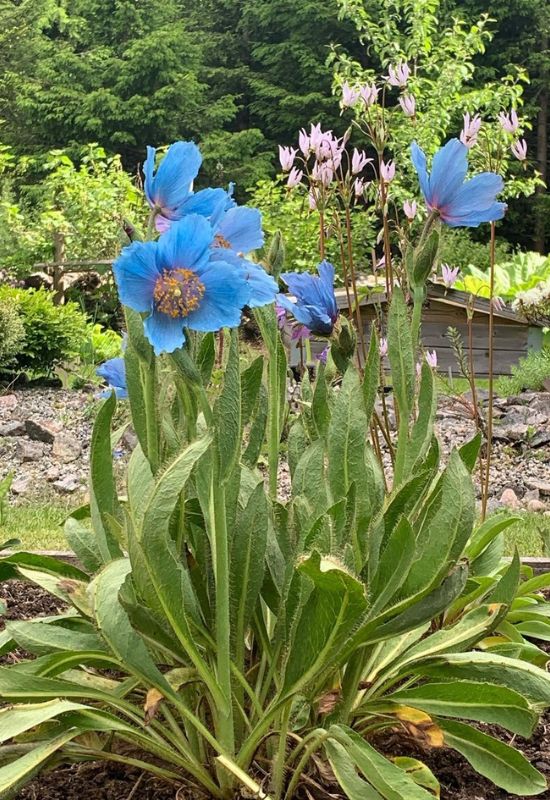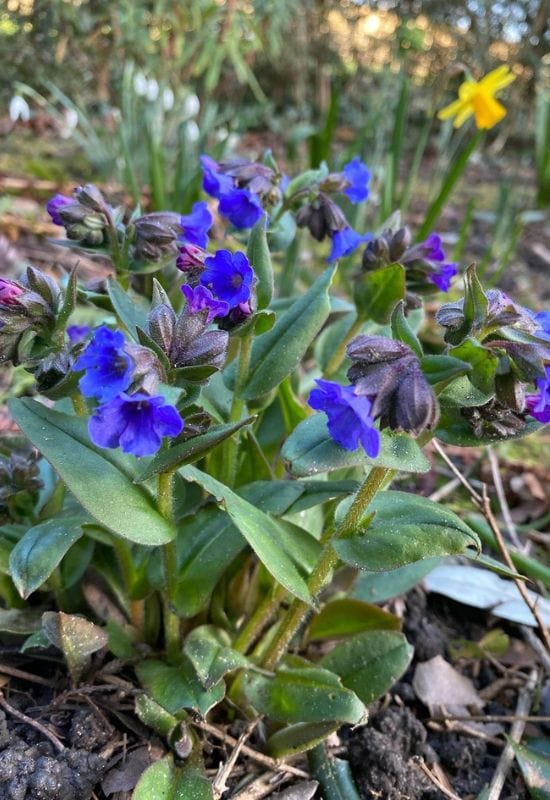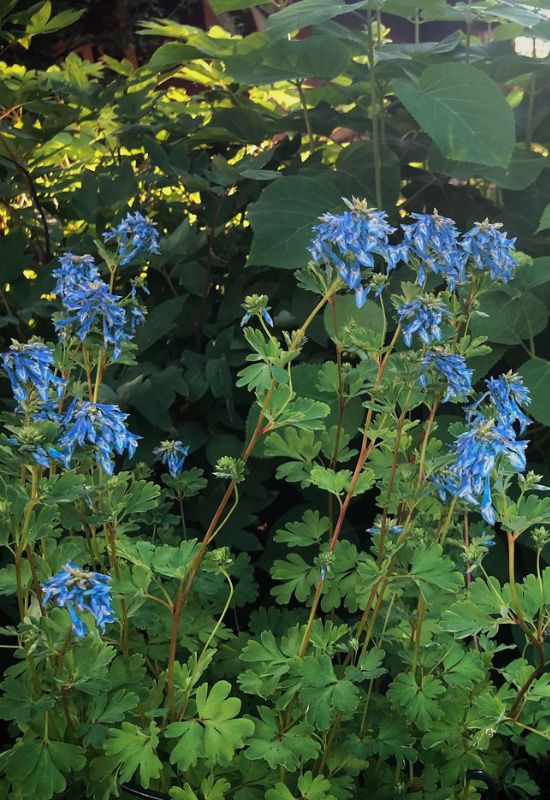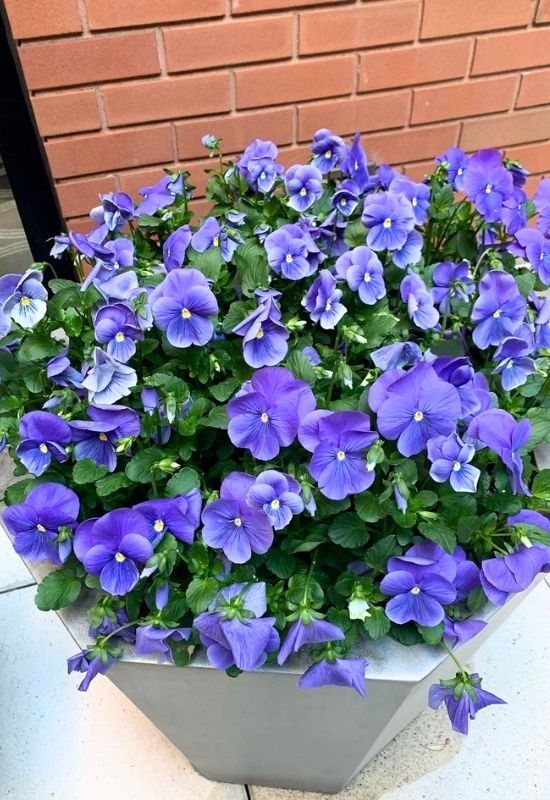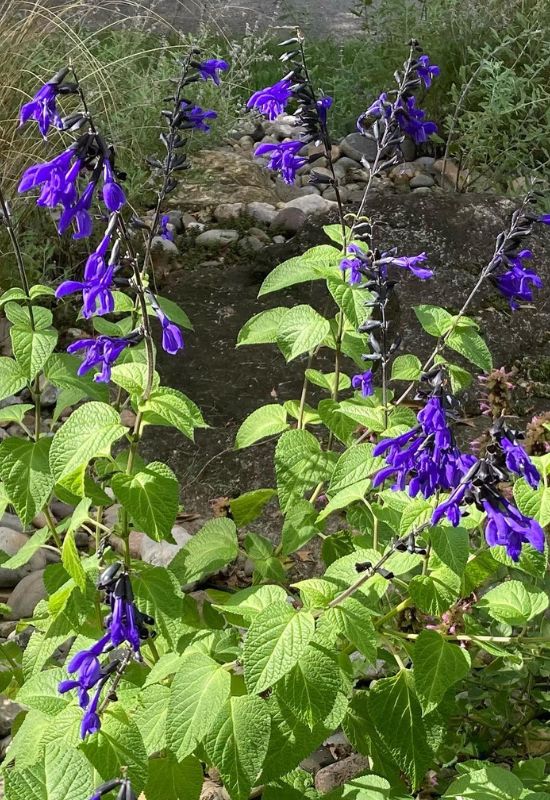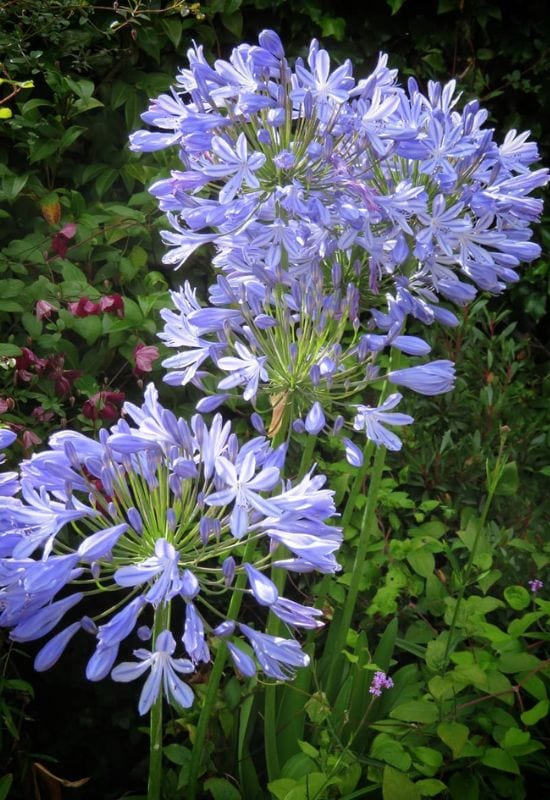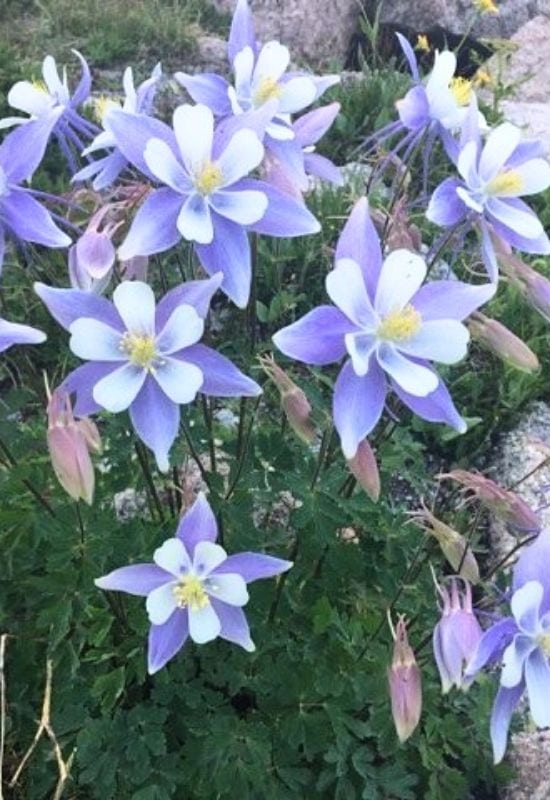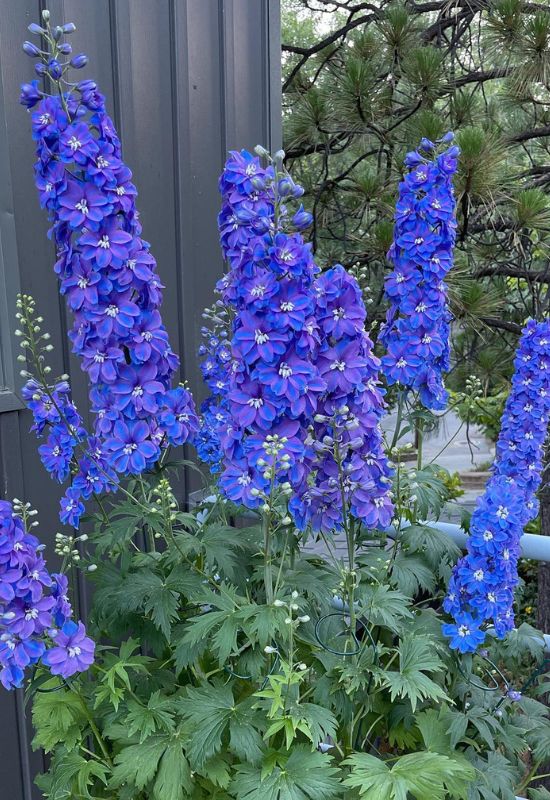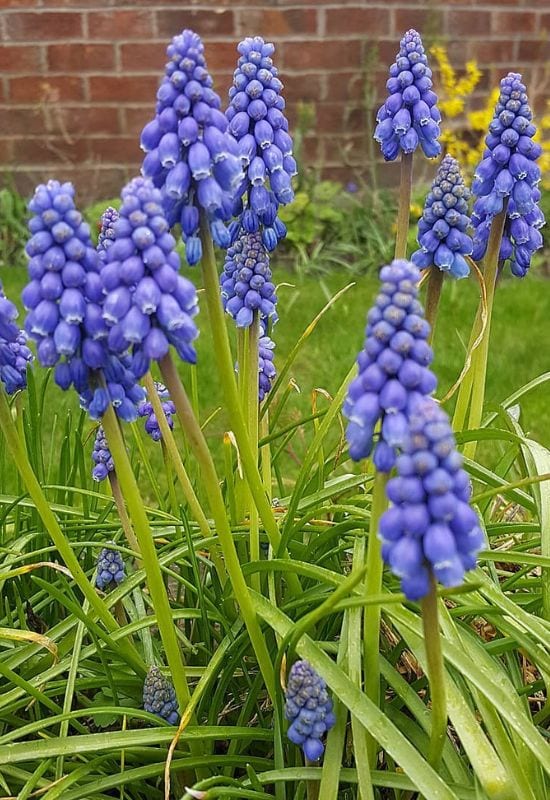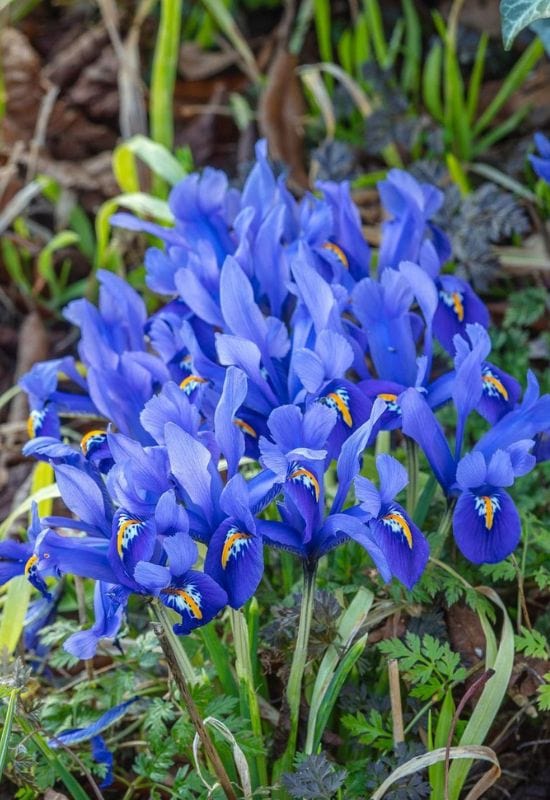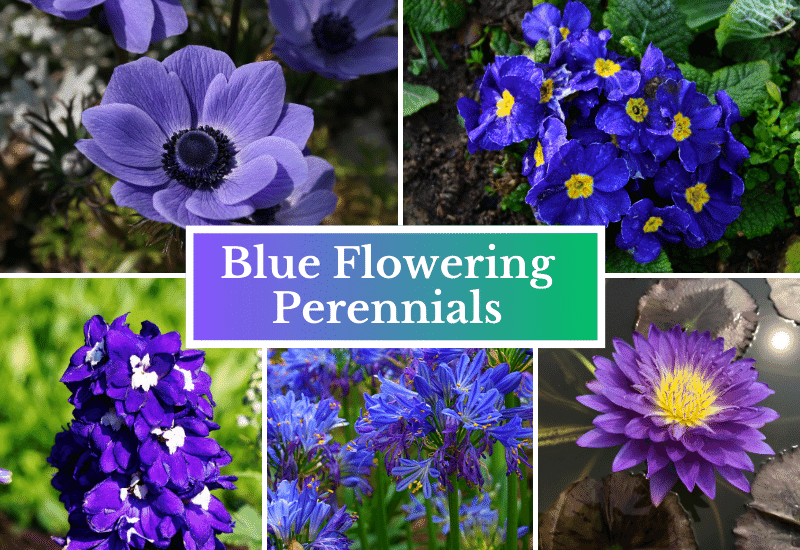
Gardens are havens of peace, calm, and natural bliss, and no flower can express this better than a blue one! Blue flowering perennials evoke calm, freshness, the charm of wildflowers, and holidays by the sea…
Since the color of the sky and deep sea is not easy to find among the flowers, blue flowers are highly sought-after in a garden. And remember, I’m talking about real blue here! Not a vague mauve or a pale purple.
Although you’ll rarely find cobalt or lapis blooms among hardy shrubs and trees, there’s a silver lining: a wealth of perennial flowers paint the celestial shades of cyan, ultramarine, deep indigo, sapphire, and turquoise with their heavenly blossoms!
Unfurling amidst lush greenery, blue perennials impart a distinctive shade to flower beds, borders, hanging baskets, and pots. These captivating perennials with blue blossoms can serve as a calming element or as a striking accent among vibrant and warm colors like yellow, orange, and red. When combined with white, they evoke the refreshing presence of a water fountain, adding a touch of serenity to any garden setting.
If you mass plant them, they can even make your garden look bigger! Yes, because the color of heaven gives a receding impression to our eyes!
So, your quest for true blue blooms that will come back year after year can be a real success, and it starts just here… So, get ready to fly in the skyline of flowering perennials in tonalities of steel, Persian, which will transform your garden into a serene and calming oasis.…
20 Flowering Perennials With True-Blue Blooms That’ll Add a Touch of Tranquility to Your Garden
And, to prove that perennials often have blue blossoms, we have a long list of 20 for you!
Regardless of whether your garden is shaded or sunlit, explore our carefully chosen selection of the most stunning blue-flowered perennials, accompanied by helpful care tips for each one.
And the very first variety I would like you to know looks like it has fallen, like a star, from the lye sky!
1: Fingered Blue Star (Amsonia ciliata)
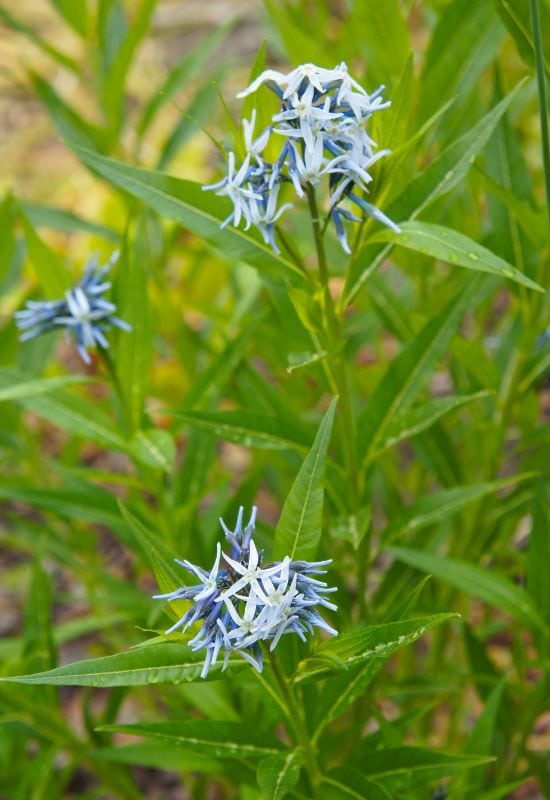
For a heavenly journey, the best start is a soft one… And so, we want to get flying with a very delicate and elegant looking perennial with blue flowers native to North America: fingered blue star…
The clusters of blossoms that appear in late spring are like a galaxy come down to Planet Earth (or your garden…) In fact, the five petals of each blossom are long and narrow, just like a star, floating in the air…
But this is all exquisitely perfected by the pale but bright sky to iceberg blue color that they display: an explosion of peace and bliss indeed! And it will all look even more enchanting when butterflies come to flutter over them!
Humble but joyful, this clump forming species will follow its floral display with long seed pods, about 4 to 7 inches (10 to 17.5 cm) that persist on till later in the season. With a harmonic personality, this plant will also give you a fresh and lush breath with its dense foliage, of long, lance shaped and bright green leaves.
But… It has a final twist for you! This leafy clump will turn bright yellow in fall, as if greeting the Sun before the cold season sets in.
Very easy to grow, fringed blue star can even naturalize in wild and woodland areas if you wish. Alternatively, it will work its heavenly magic in traditional looking beds, borders or rock gardens – but let me leave you with one tip: do mass plant it for best effect!
2: Blue Dutch Hyacinth (Hyacinthus orientalis)
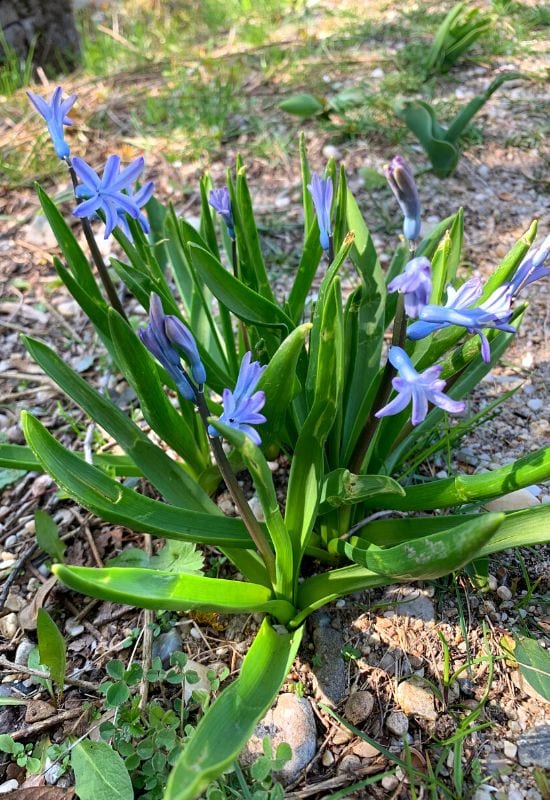
I am sorry, but I could not pick a single cultivar of Dutch hyacinth for you. In fact, this spring blooming bulbous perennial has quite a good range in the spectrum we are looking for…
For example, we could start with winner of the Award of Garden Merit by the Royal Horticultural Society ‘Blue Jacket’ if you want the purest note of vivid very light cobalt, with a darker center to the tepals…
Or you may prefer a cooler effect with the lavender blue of ‘Blue Star’, which also offers you glints of mosaic and air force in its color bouquet? Going deeper, you will find the indigo ‘Delft Blue’, yet another variety crowned by the RHS with their highest prize…
Take your pick according to your tastes and needs, but be aware that they are all incredibly fragrant. As they will all offer you dense clusters of waxy looking star shaped blooms on an upright stem and a lovely rosette of emerald green, fleshy and strap shaped leaves at the base!
Kings of spring borders, hyacinths in blue and other colors are also outstanding in rock gardens and containers, or you could use them to underplant roses and shrubs. Of course, they are also loved in window boxes and indoors.
3: ‘Blue Poppy’ Anemone (Anemone coronaria ‘Blue Poppy’)
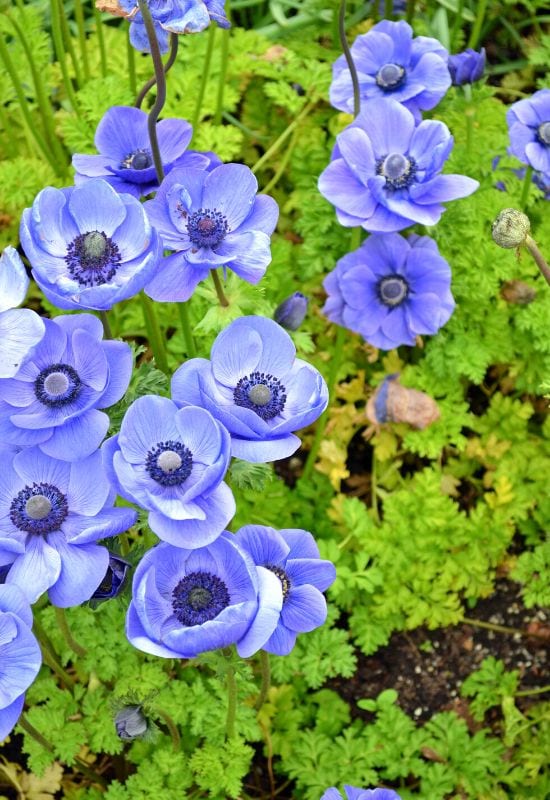
You can literally bring down drops of the sky into your garden by growing low lying ‘Blue Poppy’ anemone… This popular cormous perennial is a woodland queen, but our pick is a sun lover, and the poppy group has some of the biggest and most spectacular flowers…
In fact, they form lovely saucers with round petals that reach about 2.5 inches in diameter (4.0 cm), and they look up to you from below, like heavenly children’s eyes… And the color…
Playing along the lapis blue range, this variety brightens at the margins and intensifies at the center, where you will find a shiny, almost metallic globed button! The soft texture that these blossoms display add to a dreamy quality that is really hard to match and explain…
But it looks like butterflies really appreciate it, and I bet that so will you! When spring is over, the blossoms will fade away, but its lovely, finely cut and dense foliage will stay with you till late in the season, with a ferny and refreshing effect and great texture…
Equally suitable for flower beds or even in rock gardens or containers, or as ground cover, ‘Blue Poppy’ anemone also makes an excellent cut flower, thanks to its large and bouquet friendly blooms and sturdy stems.
4: Tibetan Blue Poppy (Meconopsis grandis)
Surely poppies are red, aren’t they? Well, not in Tibet, it seems… Actually, Tibetan (or Himalayan) poppy is not a perennial of the Papaver genus, but of the same family, Papaveraceae, and it really looks like the famous flowers of the fields of Flanders, but it is, of course, blue!
And what a striking, intense, bright and vibrant shade of cyan too! The saucer shaped blossoms have paper like petals, see through in the sunlight, and they are round and quite big, 4 to 5 inches across, in fact (10 to 12.5 cm).
Gently nodding, they open during the hot summer days in clusters (umbels) on top of long and upright stems, revealing contrasting saffron yellow anthers and a long and twisting pistil…
Some smaller leaves will grow on the stalks as well, but most of the broad, fresh and soft looking foliage is at a lush rosette at the base.
There are a few similar varieties, like Meconopsis baileyi and Meconopsis betonicifolia, but Meconopsis grandis is by far the most showy and grand – as the name suggests!
Coming from high mountains, Tibetan blue poppy is cold hardy, and unlike other varieties, it is shade tolerant… It is ideal for borders and flower beds in traditional looking spaces, like cottage gardens (for sure) and even in woodland areas.
5: ‘Big Blue’ Sea Holly (Eryngium x zabelli ‘Big Blue’)
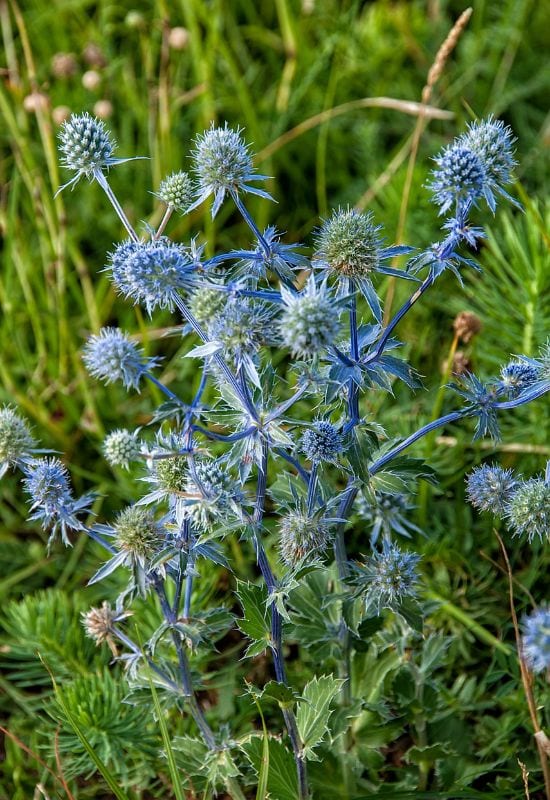
Here’s a very original looking perennial with the color of the sky for you: ‘Big Blue’ sea holly… One thing it has in common with the famous shrub it takes its name from: it is really spiky!
In fact, it may remind you of a thistle, and it has all its harsh, unruly, and wild personality! The blooms come at the top of the stems and they are steel blue in color, like stars with many sharp points that reach about 4 inches across (10 cm).
In the center, you will see an egg shaped structure, like a dome, where the actual flowers really hide… Blooming all though the summer season, it is a great favorite of pollinators, including bees, butterflies and beetles, and a great asset to the ecosystem.
The foliage picks up the thorny look of the floral display, with deeply cut and green leaves with sharp looking lobes…
‘Big Blue’ sea holly is perfect for a natural looking garden, adding a sharp note to borders and beds, or even for a wild effect… In fact, I would see it very well in a xeric, desert or Mediterranean garden. And it also makes an excellent and long lasting cut flower.
6: Egyptian Blue Water Lily (Nymphaea caerulea)
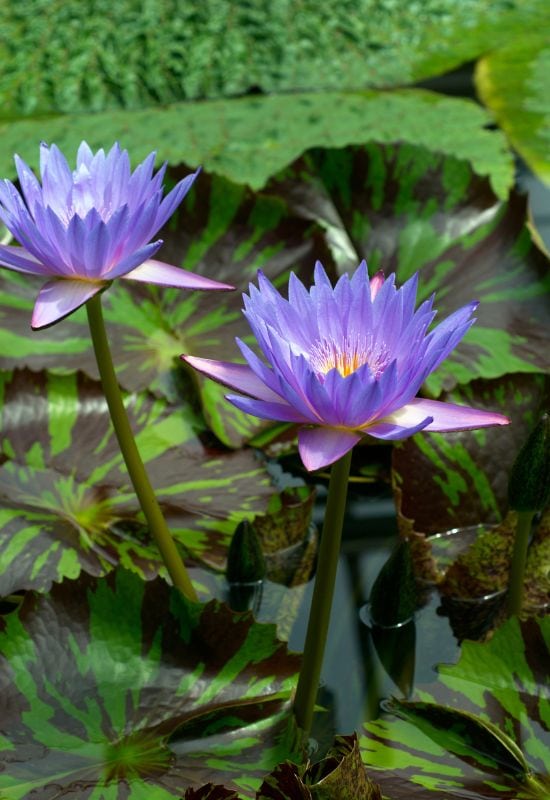
Also called blue lotus, Egyptian blue water lily is by far one of the most exotic and showy perennials you can grow in your pond!
Native of northern and central Africa, this summer bloomer will give you large, start shaped blossoms all through the summer season, each reaching 6 inches across (15 cm)!
The petals (tepals) are pointed and they come in two rows, opening in the morning to close at night. Their actual color may range on the cyan, sky blue to lavender spectrum, but it will always be luminous.
A bright golden yellow ring will draw your eye to the center, where you will meet a crown of decorative pistils, usually reddish and with violet anthers!
Once very widespread on the Nile, this Nymphaea covers the water surface with round, glossy and bright green leaves that spread to up to 16 inches (40 cm) in diameter each!
Of course, Egyptian blue water lily is an exotic looking perennial for water gardens and ponds, and it does not need much depth to grow, but it does need a wide surface, warm climate and a sunny spot.
7: ‘Blue Ensign’ Lungwort(Pulmonaria ‘Blue Ensign’)
Back to a more temperate looking (and cold hardy) perennial variety, I am pleased to present ‘Blue Ensign’ lungwort to you!
Winner of the Award of Garden Merit by the Royal Horticultural Society, it grow upright stems that display funnel shaped blossoms that open to a round mouth at the top…
These flowers will keep you company all through the spring months, and they offer you a bright lapis blue color, which intensifies in the throat.
They also open from rose buds, which will produce an interesting visual contrast. To extend this intense and energetic floral display, you should cut back the spent blossoms.
Very easy to grow, it will also give your garden semi evergreen foliage with basal clumps of lush, bright green elliptical leaves.
And you may also enjoy some scattered whitish dots over the upright foliage (some plants develop them, others don’t – just take it as a surprise!)
Excellent ground cover for shady gardens, ‘Blue Ensign’ lungwort is also great perennial for beds, borders, banks and slopes in any natural looking garden.
8: ‘Starlight’ False Indigo (Baptista x bicolor ‘Starlight’)
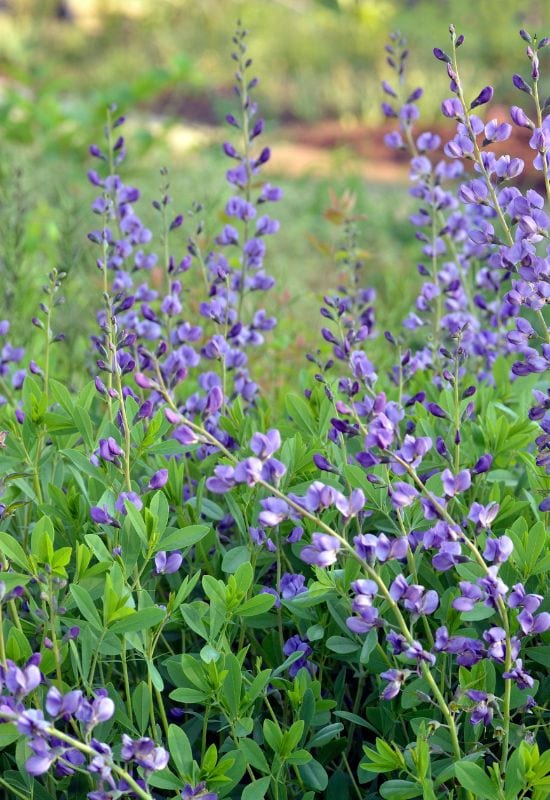
The profusion of flowers that ‘Starlight’ false indigo offers you makes it a very useful perennial for any sunny garden… Pea shaped, they are actually bicolor, with some white in it, but the dominant shade is definitely on the blue range, and it may vary, from sky to lavender in the exact tonality.
The blossoms come in late spring and early summer on long and upright stems that hold quite striking panicles indeed!
You can then cut them after the blooms are spent, which will give strength to the roots, but some gardeners like to leave them on, as they produce decorative seed pods for later in the season.
Clump forming, this cold hardy variety will give you dense, bright to mid green and decorative foliage at the base, each leaf being split into three oval leaflets.
If you prefer a darker shade, you could instead choose a close sister, called blue wild indigo instead (Baptista australis). Both will attract lots of butterflies and even hummingbirds!
A must have perennial in cottage gardens, and absolutely rewarding and generous in herbaceous borders or wild prairies, ‘Starlight’ false indigo has a traditional looking personality that suits most informal landscaping styles.
9: Blue Ornamental Onion (Allium caeruleum)
For a totally different flower shape, there’s a bulbous perennial native to Asia that can bring balloons down from the sky: ornamental onion. In fact, it is also called blue globe allium because its inflorescences (umbels to be technical) for perfect spheres of about 3 inches in diameter (7.5 cm)!
These are literally packed with small star shaped flowers, which open from pyramidal buds, usually pink. The color that these blossoms have is blue, and I have seen some specimen on the bright sapphire tonality, some take on sky to cyan notes.
Lasting from late spring to early summer, these “glitter balls” from the heavens have gained it the coveted Award of Garden Merit by the Royal Horticultural Society.
And all this floral display will hover high above a basal tuft of fleshy and lush, bright green and strap shaped leaves, being noticed and loved by butterflies, bees and other pollinators.
Group plant the bulbs of blue ornamental onion in the fall and it will give structure, shape and heavenly colored blossoms to your beds and borders in informal landscape, and it is perfect for cottage gardens and to naturalize. Or as cut flowers as well!
10: Siberian Squill (Scilla siberica)
As the name suggests, this bulbous perennial is very cold hardy indeed, and you can even grow it in the most freezing areas of Canada! What it does not tell you is that Siberian squill also has some of the loveliest blossoms in blue you can imagine!
They are smallish, true, less than 1 inch across (2.5 cm), but they nod shyly in little clusters on the upright stems, star shaped and with petals that arch beautifully forward, like grasping the air…
The notes they hit with their tonalities include deep cyan and sky blue, often with darker veins in the middle of each tepal. A single bulb will produce 3 or for flowering stalks, and this will literally announce the new season.
In fact, they are some of the earliest bloomers ever, together with snowdrops and crocuses – and they also look great together.
The lush and bright green basal tuft of strap like leaves completes the fresh show of Scilla iberica, which convinced the Royal Horticultural Society to grant it the prestigious Award of Garden Merit!
I really love the blue and starry blooms Siberian squill in low spring flower beds. However, you can also use it to underplant shrubs and trees, and even allow it to naturalize and propagate spontaneously under lawns and in wild areas. But its very best setting is, in my opinion, in a rock garden.
11: Blue Spider Lily (Tradescantia andersoninana)
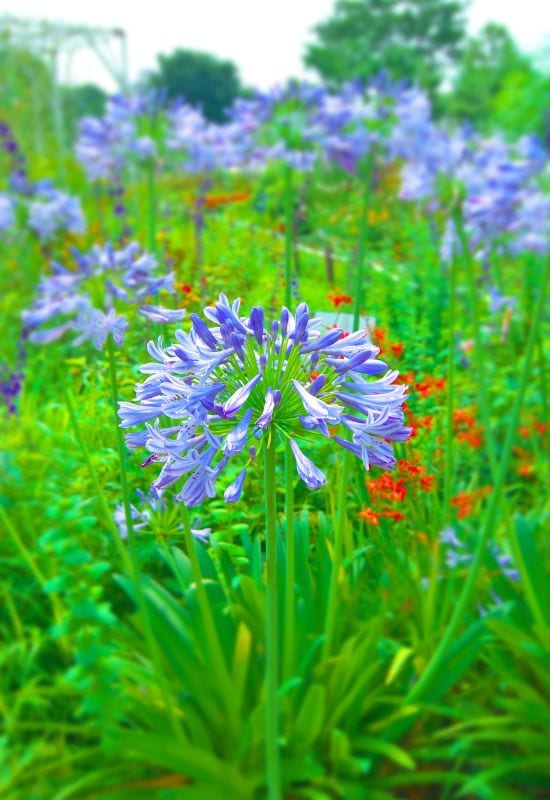
Native to Central and Southern US states, spider lily is the Tradescantia variety with the best blues… In fact, this tufty and shade loving perennial is a heavenly garden friend from the underbrush of dense forests, and it offers quite a good palette.
The flowers famously have only three petals, which sets them off from most others, and they are about 1.5 inches across (4.0 cm), and then you can take your pick… For example, ‘Blue and Gold’ is distinctive thanks to its deep azure blossoms but with yellow pistils.
On the other hand, ‘Blue Stone’ offers you a vibrant cobalt tonality that’s quite amazing… But there is also the popular ‘Zwanenburg Blue’, which, however I have seen produce blooms from pale to dark in color.
But maybe the most striking is ‘Sweet Kate’, with a floral display on the nighttime blue to violet scale, but amazing golden colored foliage. The other cultivars have rich green and glossy instead, but all form dense clumps of strap like leaves.
Blue spider lilies are ground cover perennials even in shady gardens and woodland areas, but also wonderful and vigorous green friends for flower beds, rock gardens and containers, and they will thrive even in wet soil, so, next to ponds and streams!
12: Fumewort (Corydalis elata)
Native to China, fumewort really has an exceptional pitch when it comes to blue blooming perennials. In fact, you will be really hard put to find such a brilliant and vivid tonality of cobalt in the whole world.
The exact shade that Corydalis elata hits may depend a bit on the specimen or the growing conditions, but there is no doubt that the heavenly heights of color it can achieve are – to say the least – extraordinary!
And this miracle of Nature will occur from late spring to mid summer with long, slightly nodding, or descending tubular blossoms that flare up in clusters on thin, straight and upright stems.
The contrast is really attractive, like droplets or pendants dangling in the air… But this clump forming plant also has much more on offer.
The mound of foliage at the base is incredibly lace like, because the leaves are deeply cut into many lobes and… They are rich green, but they also take on yellow hues as the season progresses!
Being self seeding, fumewort is ideal to bring amazing blue, yellow and green notes in naturalized and woodland areas, but it won’t disappoint you if you grow it in beds and borders in traditional, cottage or even rock gardens!
13: Blue Pansies (Viola x wittrockiana)
The Viola genus has one of the most complete palettes of all perennials, and pansies (Viola x wittrockiana) are no exception, and we can only look at a few varieties with our peaceful color…
With blooms that range between 2 and 4 inches across, (5.0 to 10 cm), they are also some of the most showy and decorative… Take ‘Light Blue’ and ‘Crystal Light Blue’, for example; they will offer you a darker and lighter shade sky blue with a small but eye catching yellow center…
Alternatively, you may wish to grow ‘Matrix True’, with very large blossoms that display a vibrant and intense lavender shade, with small darker veins in the middle of the petals.
Otherwise, ‘True Blue’ brings cerulean notes to their darkest and most vibrant potential. Getting even darker, ‘F1 Inspire Blue Blotch’ reaches nighttime depth with an even darker blotch in the middle, while ‘F1 Inspire Plus Blue Velvet’ goes into the very depth of sumptuous darkness with violet, indigo and almost black…
All fragrant, and all will give you that lustrous green and lush foliage with small and lobed leaves clumping at the base.
Queens of flower beds, pansies can easily adapt to containers and rock gardens as well. Whichever you choose, their amazingly long flowering season will bring the blues to your garden all through the season.
14: ‘Blue Enigma’ Anise Scented Sage (Salvia guaranitica ‘Blue Enigma’)
‘Blue Enigma’ is an outstanding cultivar of anise scented sage, a shrubby perennial from Argentina, Brazil, Paraguay and Uruguay, which really brings out the most impressive color from the mother species.
In fact, you won’t believe your eyes when you see what deep, vibrant, energetic and powerful shade of royal blue, its flowers have – almost electric!
Blooming from the middle to the end of the season, the blossoms are long, tubular and lipped, and if you look at them from the side, they may remind you of sock puppets with their mouth open to shout…
But this does not deter butterflies, bees and especially hummingbirds, who come in great numbers to feed on its sweet nectar. Taller than many other Salvia varieties, it can bring this floral display to eye level…
But the name comes from the lush, bright green and lanceolate, but almost cordate (heart shaped foliage).
In fact, if you bruise the leaves, they give off the sweetest anise aroma, and this has contributed to it winning the Award of Garden Merit by the Royal Horticultural Society.
‘Blue Enigma’ is a perfect herbaceous border perennial in informal settings, including cottage, city and Mediterranean gardens, and I can see it work very well in naturalized areas too!
15: Blue African Lily (Agapanthus spp.)
African lilies can give your garden huge blooms in shades of blue in mid season, and there are a few varieties I can suggest to you…
All offer large spherical umbels with many trumpet shaped flowers, up to 100 in each inflorescence, in fact, and for a diameter that can reach 8 inches across (20 cm)!
So, ‘Black Buddhist’ has vibrant and dark berry blue blossoms which nod when they open… On the other hand, winner of the Award of Garden Merit by the Royal Horticultural Society ‘Northern Star’ gives you tonalities on the lapis to cobalt range, packed with energy!
For a lighter effect, you may like ‘Blue Heaven’ with a bright, pale, pastel air force base and lavender notes… Finally, ‘Luly’ takes you to the heavens with its delicate sky blue, and it too has received the most important RHS prize!
Whichever you choose, you will enjoy the showy blossoms in long, upright stems, but also the lush, fleshy and strap shaped foliage at the base.
Grow your blue African lilies in flower beds, borders or containers in informal gardens; they are quite adaptable to many styles and add a geometric accent and bright colors that can lift up any space. And in fact, they could even work well in formal landscaping.
16: Blue Columbines (Aquilegia spp.)
Another genus that has blue in its palette is Aquilegia, and we can look at some perennial columbines that you can grow in your garden.
Their flowers are exceptional thanks to their complex shape, with a central crown and star shaped petals to frame it (like daffodils) but also “horns” at the back… Let’s start with rocky mountain columbine (Aquilegia caerulea) with pastel lavender that pales to almost white in the middle – very delicate indeed!
Moving towards the violet range, Alpine columbine (Aquilegia alpina) with its nodding blossoms has a really vibrant energy, on the other hand…
For an intense and dark lilac blue display, you could choose fan leaved columbine (Aquilegia flabellata)and its oval tepals and small ivory crown is just perfect. Or, totally different, is double cultivar Aquilegia vulgaris ‘Winky Double Dark Blue White’, whose blossoms look more like a Persian buttercup (Ranunculus asiaticus).
Well, take your pick, and also enjoy green and finely textured clump of foliage they offer you, thanks to their deeply and delicately cut leaves.
Cold hardy and very rewarding, all these varieties of blue columbines will adapt to many places in informal gardens, including beds, borders, rockeries and even naturalized areas.
17: Blue Larkspur (Delphinium spp.)
There is a huge range of blue varieties of larkspur, a perennial that offers you long inflorescences that reach up to the sky on straight stems, perfect for a heavenly vertical accent in your garden…
Let’s pick just a few… To start with, there’s a whole group of cultivars from the Pacific hybrids called ‘Black Night’, and they have the darkest tonalities you can imagine, including nighttime and navy…
For a light but intense note, maybe Delphinium elatum‘Million Dollar Sky’ and its strong cerulean to cyan double blossoms could be one of the best. Vibrant cobalt is instead the color of the floral display you get from Delphinium elatum ‘Million Dollar Blue’….
And then there’s the delicate azure to lavender tonalities of ‘Blue Lace’ candle larkspur, from the New Millennium Series… It’s really impossible to name them all, but each will produce a beautiful clump of rich green, cut leaves at the base, like mound at the feet of the towering flower spikes.
Blue larkspurs (and of other colors) are a must have in any cottage garden, but even in less “freestyle” designs, and in fact in any informal space, they are great in beds and borders in group planted, and also excellent cut flowers.
18: Blue Grape Hyacinth (Muscari spp.)
Grape hyacinth may be one of the bulbous perennials we most identify with the color of the sky… In fact, if you have seen the seas of blue they create in wild open woodlands, you will know the amazing feeling of awe that these tiny plants can produce in spring.
One of the most widespread species is Muscari armeniacum, which has the dense clusters of bell shaped florets typical of this genus in a range of blues, but also white and purple… One of its cultivars, ‘Baby’s Breath’ is noted for the pale sky blue of its blooms, for example.
Alternatively, you could grow Muscari azureum, and its name is a giveaway of its cyan shade… All these varieties have won the Award of Garden Merit by the Royal Horticultural Society!
But I wouldn’t discount Muscari aucheri ‘Ocean Magic’ for a delicate effect, thanks to its lavender notes… the dense floral clusters will crop up from a lovely, lush, rich green rosette of upright and fleshy strap like leaves.
I believe grape hyacinths are a must in rockeries, in blue or other colors, but they also look great mixed with other bulbous perennials in flower beds, or in containers, and they are perfect to underplant deciduous trees and shrubs!
19: ‘Blue Moon’ Woodland Phlox (Phlox divaricata ‘Blue Moon’)
How about mixing a heavenly scent to blooms in the color of the sky to your garden? Yes, you can, as long as you grow ‘Blue Moon’ woodland phlox, a perennial variety of this much loved and easy to grow flowering plants…
And it is also very much appreciated by butterflies and hummingbirds as well! This cultivar is particularly noted for its compact habit and very full blossoms as well.
In fact, the clusters of flowers with five oval petals create a mound of color that totally hides the dark green lance shaped leaves that grow on the sticky stems underneath…
The exact tonality hits lovely notes of lavender to pale sapphire, in a bright pastel rendition, and this makes it very peaceful, and blissful indeed. Blooming in spring, it will also enchant you with its distinctive and overwhelmingly pleasant fragrance!
Group or even mass plant ‘Blue Moon’ woodland phlox for best effect, and you can have its dreamworld blooms and scent in rock gardens, flower beds or borders. However it is also excellent in naturalized areas, as ground cover and to underplant shrubs and deciduous trees.
20: Blue Iris (Iris spp.)
We finally come to a perennial queen of gardens with lots of blue hues: iris! Actually, it would deserve a full article for itself, but we can try to have an overlook…
The triptych of blossoms at the top is as iconic as it gets, with the unusual habit of the petals, with standards (the top ones) and falls (the bottom ones) that show the landing spot for pollinators with a colorful blotch, called “the signal”, which sometimes also has a “beard”.
And the first is bearded variety (Iris germanica), ‘Cloud Ballet’, ruffled winner of the Honorable Mention Award thanks to its bright azure full blossoms… Instead, of the same species is ‘Clearance’ but with a striking contrast of snow white in the center and deep indigo all around…
For smaller spaces, dwarf ‘Clairette’ (Iris reticulata)has sky with a cobalt patch on the lower lip and elegant, slender tepals, while her sister ‘Harmony’ moves into deep navy to nighttime, with a hint of violet.
But for a perfect cyan and cobalt, Dutch Iris (Iris hollandica) ‘Blue Diamond’ is unbeatable… Also loved for the blade like, sometimes evergreen leaves at the base, which can be ice bluish to rich green, all these, and other, varieties are really priceless!
Depending on the variety you choose, irises can bring the color blue to flower beds and even borders, rock gardens or pond sides; some will survive dry spells, others will fit inti even small containers while yet others will spread and propagate naturally. By far one of the beat perennials in this color ever, it is one of your best gardening friends ever!
But Isn’t There a Notable Absence on Our List of Blue Perennials?
‘Hold on,’ you may say, ‘Why is there no orchid?’ True, you may have seen pictures of moth orchids (Phalaenopsis spp.) in blue… But to be honest, this species does not have that color! What you see are photoshopped images.
But orchids are the most amazing flowers in the world, with the most complete palette of any flowers…
The problem is that there are some blue ones, especially in the Thelymitra genus (e.g., T. nuda, T. cyanea and T. ixioides), but they are not easy to grow, they are hard to find, and – in short – more for botanical gardens and collectors than the common gardener…

Written By
Margie Fetchik
Margie and Arkansas native has an extensive background in gardening and landscaping. For the last 40 years, Margie has called the Colorado Rocky Mountains her home. Here she and her husband of 36 years raised three kids and owned a successful landscaping company. Margie has a CSU Master Gardener certification. She specialized in garden design & installation, perennial gardens, turf grasses & weeds, flower containers, and the overall maintenance of allHOA, commercial and residential accounts. She and her husband now reside in Denver and are excited about the new experiences’ city life holds.

